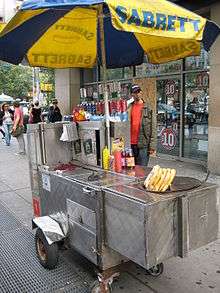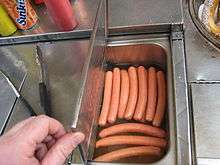Hot dog cart
A hot dog cart is a specialized mobile food stand for preparing and selling street food, specifically hot dogs, to passersby.[1] In some jurisdictions, a cart operator must meet stringent health regulations designed to protect the public. Hot dog carts are quick and easy food services, supplying millions of people with food every day. In 2015 the U.S. Hot Dog Council estimated that 15% of the approximately 10 billion hot dogs consumed by Americans in 2014 were purchased from a mobile hot dog vendor cart.[2][3] Hot dog carts are very common in New York City,[4][5] and most of the hot dogs purveyed by hot dog carts in New York City are sourced from Sabrett.[1]

Overview

A hot dog cart is generally a compact cart, fully self-contained and designed to serve a limited menu.[6] The hot dogs are often kept hot within a pan of hot water, and some refer to them as "dirty water dogs" per this method.[1] An on-board cooler is used to keep the hot dogs safely chilled until ready for reheating. It also provides cold storage for beverages, such as sodas, and multiple sinks for washing and cleaning utensils. Most hot dog carts use propane to heat the foods, making them independent of electrical power. Some carts may also be fitted with a propane grill, griddle, deep fryer, or other such cooking appliance.[7] A colorful umbrella[8] is often installed to protect the food preparation area from contamination, provide some shade, and advertise the cart's location.[9]
Construction
Hot dog carts are generally built from materials that resist corrosion, are hygiene friendly, and are easy to clean.[10] They are often made of stainless steel,[11] but some carts also have components made from plastic, wood, or fiberglass. The food preparation body of the cart is often mounted on a chassis that can be easily towed, to a vendor's location by a vehicle or pushed to a location by hand. Types of carts may vary from a lightweight push cart of only about 200 lbs (90 kg), to fully enclosed walk-in carts weighing 1/2 a ton or more.[7]
Issues
Although hot dog carts can be equipped to cook a variety of other meats and foods from fresh or raw states, local health code regulations in the U.S. and Canada governing food safety and the types of food that can be sold from mobile food stands usually limit hot dog carts to selling reheated pre-cooked wieners and sausages. These health code regulations vary widely from state to state and county to county. In addition, health regulations often limit what side dishes, condiments, and garnishes may be sold from a mobile food cart, which are potentially hazardous foods, foods at high risk for spoilage due to rapid bacterial growth at certain temperatures. For example, and it is rarely done, but some stands may offer eggs and dairy products. Meats that are considered to be hazardous, such as pork and poultry, may also be banned from sale at mobile foods stands. Bacon Wrapped dogs are typically forbidden, however a common workaround is offering pre-cooked bacon bits as a condiment. Hot dogs are only served on buns with certain approved condiments such as, but not limited to: mustards, pickles, pickled relishes, chopped onions, and tomato ketchup.[12]
Health regulations
Health code regulations are usually dictated by county health departments, and as a result, they vary widely across the United States and Canada. In addition to determining what types of foods are allowed to be served, these local codes often specify mandates of what equipment should be installed on a mobile food cart. Such codes also ensure that the food cart has built-in facilities for achieving appropriate hygiene levels for the cart, the equipment and utensils being used, and the operator handling the food. This may include hot and cold running water, an insulated ice box, and a number of separate sinks for washing hands and utensils. Some areas specify that a cart have as many as four of these sinks. In addition, local health codes may require the cart to be physically inspected by the local health department, and that a cart operator attend a training course in safe food handling and preparation.[13] This is why, when planning to start operating a hot dog cart, the first thing one should do is to contact the local health department and ask for the person in charge of the restaurant inspections. This is the person that will tell you the features you can and can't have on your cart.[14]
Manufacturing and sales
Although the hot dog is considered an American food invention dating back to New York in the late 19th century, cart manufacturers ship hot dog carts all around the world, including Europe, Asia, South America, and the Middle East.[3]
See also
References
- Gordinier, Jeff (August 10, 2011). "The Hot Dog, Redefined One Cart at a Time". The New York Times. Retrieved January 4, 2018.
- "The Cheap Eats Tradition of the Classic Hot Dog Cart is Alive in New Hampshire". New Hampshire Magazine. Retrieved January 3, 2018.
- National Hot Dog and Sausage Council
- Kraig, B.; Carroll, P. (2012). Man Bites Dog: Hot Dog Culture in America. Rowman & Littlefield Studies in Food and Gastronomy. AltaMira Press. p. 77. ISBN 978-0-7591-2074-7. Retrieved January 3, 2018.
- Lynch, Scott (April 20, 2017). "The 12 Best Hot Dogs In NYC". Gothamist. Archived from the original on January 13, 2018. Retrieved January 4, 2018.
- Kraig, B.; Carroll, P. (2012). Man Bites Dog: Hot Dog Culture in America. Rowman & Littlefield Studies in Food and Gastronomy. AltaMira Press. p. 89. ISBN 978-0-7591-2074-7. Retrieved January 3, 2018.
- Indiana State Dept of Health - Retail Food Establishment Sanitation Requirements - page 61 - Equipment Design and Materials
- Kraig, B. (2009). Hot dog: a global history. The Edible Series. Reaktion Books. p. 44. ISBN 978-1-86189-427-4. Retrieved January 4, 2018.
- Willydogs Operations Manual
- Restaurant Business (in French). Restaurant Business. 1989. p. 224. Retrieved January 4, 2018.
- Panaggio, T. (2013). The Risk Advantage: Embracing the Entrepreneur's Unexpected Edge. River Grove Books. p. 123. ISBN 978-1-938416-45-3. Retrieved January 4, 2018.
- Illinois Department of Public Health - Food Safety fact Sheet for Temporary Food Stands
- http://www.mchd.com/pdf/fdphotdogcarts.pdf Marion Indiana County Health Department - Hot Dog Cart Regulations Guide
- How To Start A Hot Dog Cart Business - Getting a health department or agriculture permit
Further reading
- "Before Wieners Were $30: A Brief History of Hot Dog Carts". Newsweek. March 31, 2016. Retrieved January 4, 2018.
